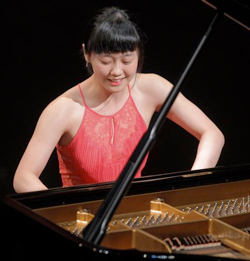by Robert Rollin

Dong, a first-prize winner of the Schumann International Piano competition for Young Musicians, the Asia-Pacific International Chopin Piano Competition, and the Steinway and Sons International Youth Piano Competition, has debuted with orchestras in New York, Paris, Hong Kong, and Aspen, Colorado. She was also a finalist in the 2013 Van Cliburn Competition.
The first movement, Allegro molto moderato, after its short timpani roll opening, immediately presented a brilliant piano cadenza performed by Dong with steely precision and poised expression. She showed great rhythmic control and played her solo passages masterfully, but without being overbearing or excessively forceful. Conductor Randall Fleischer maintained careful control of the musical flow—always shaping the evolving interplay of horn solos, cellos, other members of the orchestra, and the piano solo. After the cello section theme restatement, Dong returned with a flashier cadenza replete with terrific muscular playing and lots of decorative trills.
The slow movement, Adagio, began in the distant key of D flat major and negotiated an interesting movement to the parallel minor. The lyrical orchestral introduction included lovely solos in horn and oboe, and a short cello section lead, after which the piano took over to unfold thematic statements further. Beautiful second-theme interplay among clarinet solos, horn solos, and the piano led to a fortissimo recurrence of the theme shared by piano and orchestra.
The final D flat major piano arpeggio was interrupted by the finale’s sudden tutti onset. Reminiscent of the Norwegian Halling Dance in which several men try to kick a hat off of a pole, the sturdy anacrustic duple meter, full of insistent eighth-note repetitions, served as a means of constructing lively full orchestra passages alternating with powerful solo piano statements. Colorful string tremolos enriched the softer passages. After a short slow interlude, the original dance theme returned with lively pizzicato string accompaniment, timpani rolls and a rousing close.
Dong’s encore was a garishly virtuosic Mozart Rondo alla Turka transcription which she tossed off effortlessly. Double octave passages were legion, and virtuosity remained unconstrained for the entire movement. Needless to say this produced a standing ovation, though one longed for some expressive playing to match the technique. Interestingly enough, the concert had opened with Mozart’s Overture to The Abduction from the Seraglio, K 384. The use of Turkish Janissary music in both selections made for a nice connection. Lots of cymbals, bass drum, and triangle enlivened the overture.
The concert’s second half consisted of a solid reading of Brahms’s Symphony No. 3 in F Major, Op. 90. The symphony could not be more different than the ornately decorated Janissary music in the Mozart Overture, or the virtuosic Grieg piano concerto. Brahms uses very little percussion, relying more on the intricacy of his musical ideas, which are often full of hemiolas, cross rhythms and contrapuntal treatment.
The first movement, Allegro con brio, began with a complex texture led by the strings, but shared with the solo French horn. The small size of the Youngstown Symphony string section created no problems in the Mozart or Grieg, but here the solo horn opening entrance completely drowned out the lead string texture. The proper size of each violin section should be about twenty players, and, for this evening, there were only nine first violins. The smallness of all five string sections contributed to an imbalance throughout the performance.
Notwithstanding, the performers gave more than one hundred percent and produced a fine rendition. The second subject produced glorious clarinet, flute, and oboe solos, and excellent woodwind playing in general. The closing theme had lovely solo passages in all the woodwinds as the strings accompanied beautifully. The short development and powerful recapitulation added brasses at the climaxes. The interesting, prolonged coda alternated woodwind, brass and string sections until the final tutti closed the movement with power and grace.
The clarinets, bassoons, and horns excelled in the quiet second movement, Andante, playing the lead roles in the main and second themes that alternated in an enchanting Rondo. Brahms employed a reduced orchestra of strings, woodwinds, and only two horns in the third movement, Poco allegretto. The opening in strings and woodwinds is a theme of unparalleled beauty. The performance was absolutely gorgeous. The long and multi-themed finale was also exquisite.
Published on ClevelandClassical.com October 22, 2013
Click here for a printable version of this article.



